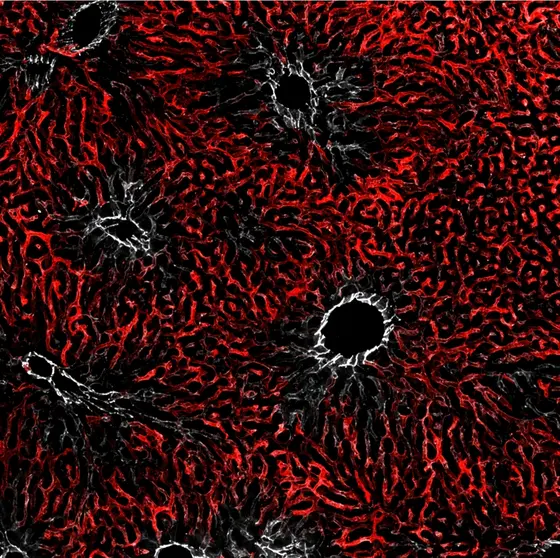It has been discovered in recent years that endothelial cells, which line the inside of all blood vessels, perform critical gatekeeper and safeguarding functions on surrounding cells. They thereby directly control the function of essentially all organs. The underlying molecular signaling pathways involved in these processes are mostly unknown. Focusing prototypically on the liver, whose regeneration is known to be critically controlled by blood vessels, scientists in the laboratory of Hellmut Augustin at the DKFZ in Heidelberg and at the ECAS in Mannheim have now for the first time succeeded in holistically dissecting the signaling networks of endothelial cells.
The recent dramatic technological advances in genome analysis allow to resolve gene expression down to the level of individual cells. This enables complex molecular organ maps and the analysis of functional interactions between cells at an unparalleled level of resolution. These analyzes are, however, mostly limited to the investigation of RNA expression, i.e. the detection of the molecular building plan of protein production. In contrast, high-resolution mapping of protein expression itself is still in its infancy.
Augustin's team now succeeded in comparing the expression of RNA and proteins in endothelial cells of the liver with high spatial resolution. To do so, the scientists employed a trick by grouping the endothelial cells of the liver into clusters of spatially adjacent cells. This enabled them to bypass the detection limits of single cell analyzes and to create comparative “maps“ of RNA and protein expression. In a further step, the researchers succeeded for the first time in examining not only protein detection but also the activation status of all proteins.
Proteins can be switched on and off by chemical modification. Most notably, the attachment and removal of phosphate residues (phosphorylation) determines their state of activity. The scientists have now for the first time generated a spatial phosphoproteome map of a specific cell population in an organ, which provides previously unimagined insight into the control of liver function by blood vessels.
Numerous signaling pathways could be identified as being spatially regulated on the level of protein phosphorylation, but not on the level of RNA or protein expression. “We zoomed in on the Angiopoietin/Tie signaling pathway as a prototypic example for the power of our experimental approach,“ explains first author Donato Inverso. “The Tie receptors are uniformly expressed on RNA and protein level by endothelial cells throughout the liver. However, their phosphorylation is spatially strongly spatially“. This highly surprising and unexpected discovery made it possible to identify a signaling loop through which endothelial cells control the metabolic functions of liver cells and also the regeneration of the liver.
In order to make the new comprehensive databases conveniently accessible for further research work, the scientists programmed an app that enables access to all data of the study via a publicly accessible website. “The very large amounts of data from genome research must not be allowed to gather dust in difficult to access databases,“ said Hellmut Augustin, head of the study. “We want to make all data available to scientists worldwide in an easily accessible manner“. The now published treasure trove of data will be an important source of liver research in the coming years, which has the potential to identify novel therapy-relevant signaling pathways.
Donato Inverso, Jingjing Shi, Ki Hong Lee, Moritz Jakab, Shani Ben-Moshe, Shubhada R. Kulkarni, Martin Schneider, Guanxiong Wang, Marziyeh Komeili, Paula Argos Vélez, Maria Riedel, Carleen Spegg, Thomas Ruppert, Christine Schaeffer-Reiss, Dominic Helm, Indrabahadur Singh, Michael Boutros, Sudhakar Chintharlapalli, Mathias Heikenwalder, Shalev Itzkovitz, Hellmut G. Augustin: A spatial vascular transcriptomic, proteomic and phosphoproteomic atlas unveils an angiocrine Tie-Wnt signaling axis in the liver
Dev. CELL 2021, https://doi.org/10.1016/j.devcel.2021.05.001ll
Scientists can access the Liver Endothelial Cell Database at:
https://pproteomedb.dkfz.de



